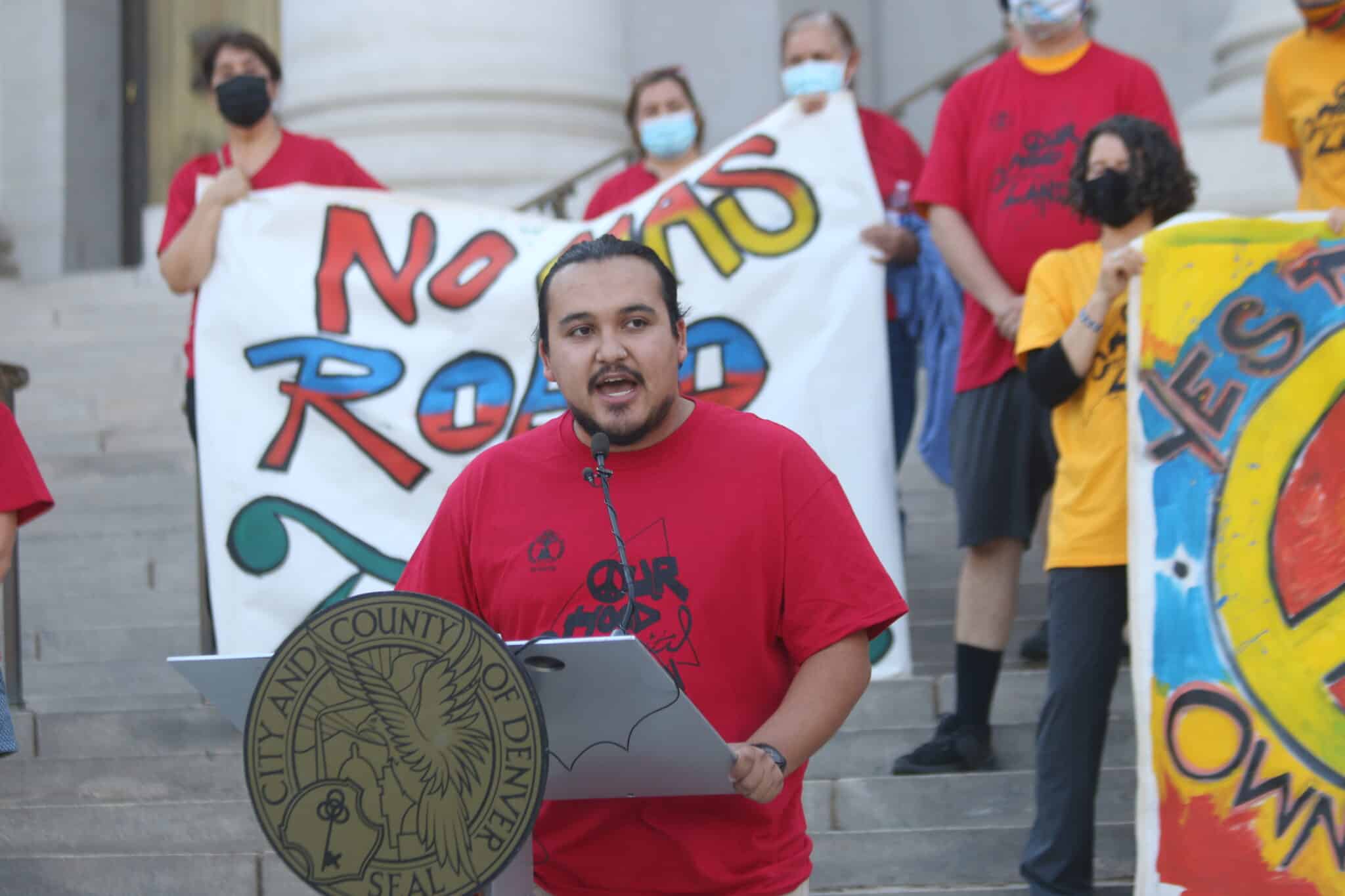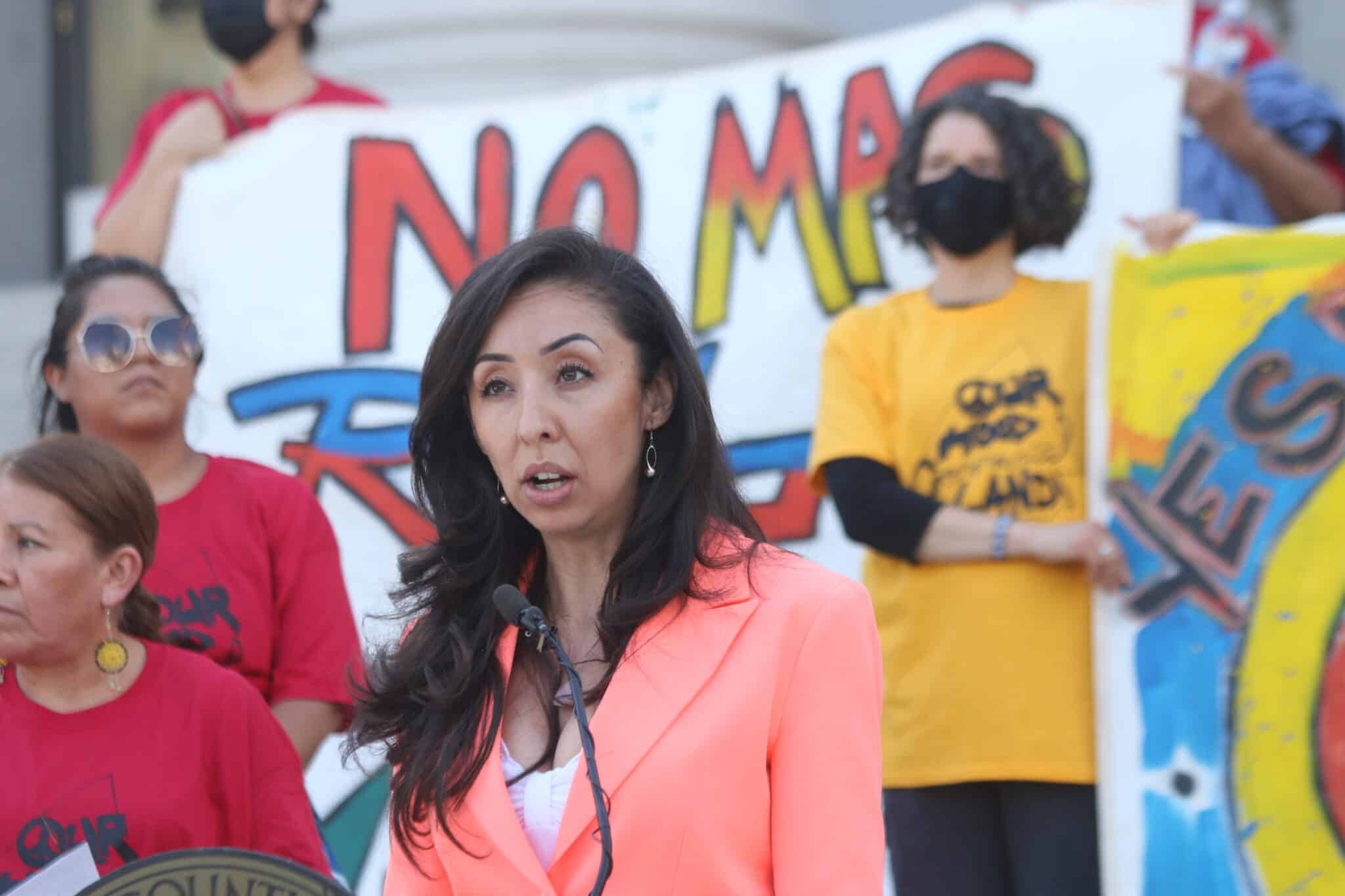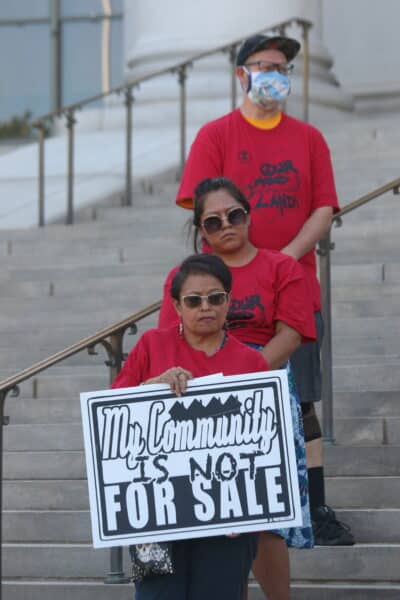
Alfonso Espino of the Globeville Elyria-Swansea Coalition for Health and Housing Justice speaks at a news conference Monday against a bond measure to fund a new arena and rehabilitation of an old stadium at the National Western Center. (Eric Heinz photos)
Denver voters will decide in November whether to fund $450 million for projects in the city, including $190 million for a new arena and the rehabilitation of an old stadium at the National Western Center.
The City Council on Monday voted to forward the bond measure to the ballot, although there is opposition from some residents who live in the Globeville and Elyria-Swansea neighborhoods.
The new arena with more than 8,000 seats and the transformation of the old 1909 Stadium into a food market are part of a slate of five bond measures, which could pay for infrastructure projects as well as build and maintain libraries in the neighborhoods of Westwood, Hampden and Globeville.
They would also provide $39 million to build housing and shelters for homeless people.
The projects altogether, according to Mayor Michael Hancock’s office, would create 7,500 jobs, about $483 million in worker wages and benefits, and $1 billion in economic benefits.
Residents of Globeville and Elyria-Swansea are concerned because they believe the NWC projects will cause property taxes and rents to skyrocket. They said the tens of millions of dollars for the projects would not increase the amount of affordable housing in their neighborhoods, and said that they have their own plans for a community space.
“We’ve heard hours of testimony of our community really expressing their challenges, their issues with creating a year-long entertainment venue without any concern for housing or resources in neighborhoods that have been historically starved,” Councilwoman Candi CdeBaca, who represents the NWC area, said during a news conference before the council meeting.

Denver Councilwoman Candi CdeBaca speaks Monday in support of residents who oppose the bond measure.
CdeBaca spoke alongside members of the Globeville, Elyria-Swansea Coalition Organizing for Health and Housing Justice.
“We’re here to propose a new way of doing things, inverting the reality and the tools of a system that only seeks to marginalize us, exclude us and delegitimize our suffering and the context of that history,” coalition member Alfonso Espino said.
During the meeting, Councilman Chris Hinds, who represents downtown Denver and voted in favor of the ballot measure, said a citywide survey on the projects did not compare the proposed costs of the arena to other purposes.
“Our own district 10 residents are split on strong support and opposition to the National Western funding,” Hinds said. “That suggests to me that this is an ideal question for the voters to weigh in on in November.”
The vote to forward the stadium and arena question to the ballot was 9-4, with Council Members CdeBaca, Robin Kniech, Paul Kashmann and Amanda Sandoval voting in opposition.
Four other ballot measures were forwarded more easily.
Jenna Espinoza, a spokeswoman for Hancock’s office on the NWC project, told BusinessDen there are few locations on the campus where the arena can be constructed, but no site has been identified yet. She also said the Denver Coliseum is not planned to be demolished to make way for a new arena.
“It is important that we identify a preferred location with the community prior to advancing the design process,” Espinoza said. “The coliseum will remain and will continue to host events until the arena is built.”
Both the arena and stadium rehabilitation were originally part of a larger package of facility bonds measures, but a council committee in early August voted to separate the projects from the pack rather than risk losing more projects if voters do not approve it.

Residents of Globeville and Elyria-Swansea said they are worried that the National Western Center projects will cause nearby property taxes and rents to skyrocket.
Coalition spokeswoman Sarah Lake told BusinessDen even if the arena and stadium ballot measure passes, the residents want to work out an agreement with the NWC developers that benefits everyone affected by the project.
“Now it’s about voter education and helping them understand what they’re voting on and the (coalition’s) current plans,” Lake said.
Denver is already paying for the construction of NWC’s phases one and two through a bond measure approved in 2015 through tourism taxes to fund $775 million in construction of the overall campus and improvements to the Colorado Convention Center.
The National Western Center complex is being developed by the National Western Stock Show, Colorado State University and the city and county of Denver. CSU is in the process of building a $200 million facility for its Spur campus for “collaborative research and educational programs about water, food and health,” according to the NWC website.
The bonds for the arena and stadium rehabilitation would be paid for by property taxes, but there will be no tax increases, according to city documents.
At-large council seats to stay
The council was poised Monday to also ask voters whether the city should eliminate its at-large council seats, which represent the entire city, to reduce the number of residents in each district, but it narrowly failed on a 6-7 vote.
The measure was championed by Councilman Kevin Flynn and CdeBaca, an alliance deemed so unlikely by Flynn that he played the theme song from “The Odd Couple” on his phone before making his arguments.
“I want to emphasize again, there’s no right or wrong way to structure your council,” Flynn said. “There’s only how do you want to do it, and it may be right at this point in Denver’s history with our population growth … to reexamine the decision that was made 50 years ago (to add at-large seats).”
Flynn said because the two current at-large members, Kniech and Debbie Ortega, will be termed out by next election, this would have been the appropriate time to consider the change, as the opportunity may not come again for years.
Council President Stacie Gilmore said residents in her district, which includes Denver International Airport and nearby neighborhoods, were not given adequate opportunity to consider reallocating the seats to specific districts.
“I want to hear from my constituents; I want them to understand what I’m voting on, either for or against, and that they have an opportunity to weigh in and tell me what they think I should do,” Gilmore said. “We haven’t had a chance to understand what the different options are.”
At-large council members are elected by who gets the most votes during municipal elections, whereas district candidates must get a majority, 50.1 percent or more, or otherwise the top two from that election are entered into a runoff
.

Alfonso Espino of the Globeville Elyria-Swansea Coalition for Health and Housing Justice speaks at a news conference Monday against a bond measure to fund a new arena and rehabilitation of an old stadium at the National Western Center. (Eric Heinz photos)
Denver voters will decide in November whether to fund $450 million for projects in the city, including $190 million for a new arena and the rehabilitation of an old stadium at the National Western Center.
The City Council on Monday voted to forward the bond measure to the ballot, although there is opposition from some residents who live in the Globeville and Elyria-Swansea neighborhoods.
The new arena with more than 8,000 seats and the transformation of the old 1909 Stadium into a food market are part of a slate of five bond measures, which could pay for infrastructure projects as well as build and maintain libraries in the neighborhoods of Westwood, Hampden and Globeville.
They would also provide $39 million to build housing and shelters for homeless people.
The projects altogether, according to Mayor Michael Hancock’s office, would create 7,500 jobs, about $483 million in worker wages and benefits, and $1 billion in economic benefits.
Residents of Globeville and Elyria-Swansea are concerned because they believe the NWC projects will cause property taxes and rents to skyrocket. They said the tens of millions of dollars for the projects would not increase the amount of affordable housing in their neighborhoods, and said that they have their own plans for a community space.
“We’ve heard hours of testimony of our community really expressing their challenges, their issues with creating a year-long entertainment venue without any concern for housing or resources in neighborhoods that have been historically starved,” Councilwoman Candi CdeBaca, who represents the NWC area, said during a news conference before the council meeting.

Denver Councilwoman Candi CdeBaca speaks Monday in support of residents who oppose the bond measure.
CdeBaca spoke alongside members of the Globeville, Elyria-Swansea Coalition Organizing for Health and Housing Justice.
“We’re here to propose a new way of doing things, inverting the reality and the tools of a system that only seeks to marginalize us, exclude us and delegitimize our suffering and the context of that history,” coalition member Alfonso Espino said.
During the meeting, Councilman Chris Hinds, who represents downtown Denver and voted in favor of the ballot measure, said a citywide survey on the projects did not compare the proposed costs of the arena to other purposes.
“Our own district 10 residents are split on strong support and opposition to the National Western funding,” Hinds said. “That suggests to me that this is an ideal question for the voters to weigh in on in November.”
The vote to forward the stadium and arena question to the ballot was 9-4, with Council Members CdeBaca, Robin Kniech, Paul Kashmann and Amanda Sandoval voting in opposition.
Four other ballot measures were forwarded more easily.
Jenna Espinoza, a spokeswoman for Hancock’s office on the NWC project, told BusinessDen there are few locations on the campus where the arena can be constructed, but no site has been identified yet. She also said the Denver Coliseum is not planned to be demolished to make way for a new arena.
“It is important that we identify a preferred location with the community prior to advancing the design process,” Espinoza said. “The coliseum will remain and will continue to host events until the arena is built.”
Both the arena and stadium rehabilitation were originally part of a larger package of facility bonds measures, but a council committee in early August voted to separate the projects from the pack rather than risk losing more projects if voters do not approve it.

Residents of Globeville and Elyria-Swansea said they are worried that the National Western Center projects will cause nearby property taxes and rents to skyrocket.
Coalition spokeswoman Sarah Lake told BusinessDen even if the arena and stadium ballot measure passes, the residents want to work out an agreement with the NWC developers that benefits everyone affected by the project.
“Now it’s about voter education and helping them understand what they’re voting on and the (coalition’s) current plans,” Lake said.
Denver is already paying for the construction of NWC’s phases one and two through a bond measure approved in 2015 through tourism taxes to fund $775 million in construction of the overall campus and improvements to the Colorado Convention Center.
The National Western Center complex is being developed by the National Western Stock Show, Colorado State University and the city and county of Denver. CSU is in the process of building a $200 million facility for its Spur campus for “collaborative research and educational programs about water, food and health,” according to the NWC website.
The bonds for the arena and stadium rehabilitation would be paid for by property taxes, but there will be no tax increases, according to city documents.
At-large council seats to stay
The council was poised Monday to also ask voters whether the city should eliminate its at-large council seats, which represent the entire city, to reduce the number of residents in each district, but it narrowly failed on a 6-7 vote.
The measure was championed by Councilman Kevin Flynn and CdeBaca, an alliance deemed so unlikely by Flynn that he played the theme song from “The Odd Couple” on his phone before making his arguments.
“I want to emphasize again, there’s no right or wrong way to structure your council,” Flynn said. “There’s only how do you want to do it, and it may be right at this point in Denver’s history with our population growth … to reexamine the decision that was made 50 years ago (to add at-large seats).”
Flynn said because the two current at-large members, Kniech and Debbie Ortega, will be termed out by next election, this would have been the appropriate time to consider the change, as the opportunity may not come again for years.
Council President Stacie Gilmore said residents in her district, which includes Denver International Airport and nearby neighborhoods, were not given adequate opportunity to consider reallocating the seats to specific districts.
“I want to hear from my constituents; I want them to understand what I’m voting on, either for or against, and that they have an opportunity to weigh in and tell me what they think I should do,” Gilmore said. “We haven’t had a chance to understand what the different options are.”
At-large council members are elected by who gets the most votes during municipal elections, whereas district candidates must get a majority, 50.1 percent or more, or otherwise the top two from that election are entered into a runoff
.
